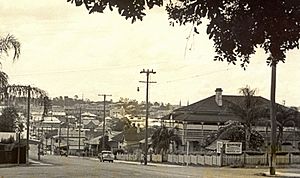Queensland Country Women's Association Girls' Hostel facts for kids
Quick facts for kids Queensland Country Women's Association Girls' Hostel |
|
|---|---|

Queensland Country Women's Association Girls' Hostel, 2009
|
|
| Location | 5 Brisbane Street, Ipswich, City of Ipswich, Queensland, Australia |
| Design period | 1870s - 1890s (late 19th century) |
| Built | c. 1885 - c. 1911 |
| Official name: Queensland Country Women's Association Girls' Hostel | |
| Type | state heritage (built, landscape) |
| Designated | 21 October 1992 |
| Reference no. | 600558 |
| Significant period | 1880s, 1900s-1910s (fabric) 1880s, 1908-1940s (historical) 1949- (social) |
| Significant components | trees/plantings, residential accommodation - main house |
| Lua error in Module:Location_map at line 420: attempt to index field 'wikibase' (a nil value). | |
The Queensland Country Women's Association Girls' Hostel is a special old house in Ipswich, Queensland, Australia. It is listed on the Queensland Heritage Register. This means it is protected because of its history and unique features. The house was built a long time ago, between about 1885 and 1911.
Contents
A House with a Past
This building started as a single-storey timber house around 1885. It was built for Thomas Towell and his wife, Sarah. After Thomas Towell passed away in 1904, Sarah became the owner.
A few years later, in 1908, a doctor named Edward Elmslie Brown bought the house. Within three years, he added a second floor to it. Dr Brown used the bigger house as his home and also as a place to see his patients.
He also built a timber hospital nearby called "Oakdale." Later, he added another hospital building and a home for the hospital's matron (the head nurse).
From Hospital to Hostel
Dr Brown died in 1941. In 1949, the Queensland Country Women's Association (QCWA) bought the house. They turned it into a hostel for young women and students from the country who needed a place to stay in the city.
Around 1960, a new brick building was added next to the house. This building, called Melody Lodge, has units for older women. One of Dr Brown's old hospital buildings is now also a QCWA hostel for older people. The matron's old house is now a private home. Sadly, the second hospital building was destroyed by fire in the late 1980s.
What the Hostel Looks Like
The building is a large, two-storey house made of timber. Its outside walls are covered with special timber boards called chamferboards. Both levels of the house have beautiful verandahs with fancy decorations.
At the back, there's a single-storey laundry area. This is connected to the main hallway by an enclosed verandah. There's also a block with bathrooms that was likely added around 1950.
The front of the house has lovely plants, including palm trees and hedges. Two special double palm trees stand on each side of the main entrance.
Why This Place is Special
The Queensland Country Women's Association Girls' Hostel is important for several reasons:
A Changing Home
The house shows how buildings in Queensland often changed over time. It started as a single-storey house in 1885 and was later made into a two-storey building around 1908. This shows how people adapted their homes as their needs changed.
Unique Design
This hostel is a great example of a large, two-storey timber house. It has beautiful details from the Federation period, like fancy flower patterns in its lacework and attractive timber decorations. Its design, size, and front garden make the street in Ipswich look very special.
Helping the Community
The hostel has a strong connection to the QCWA. It played a big part in helping young girls from country areas. It gave them a safe place to live and study in the city.
Important People
The place is also linked to important people in Queensland's history. These include Thomas Towell, an early telegraph operator, and Dr Edward Elmslie Brown, a well-known doctor and businessman.


